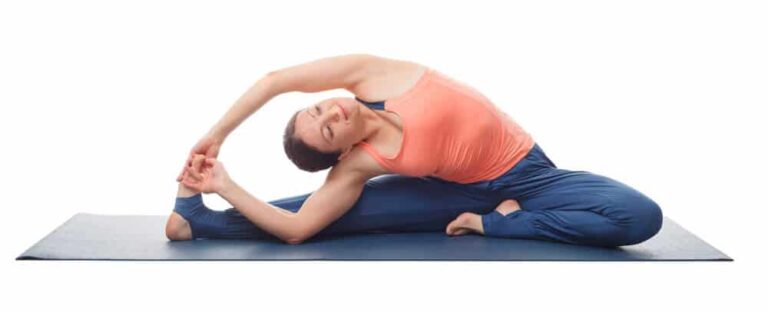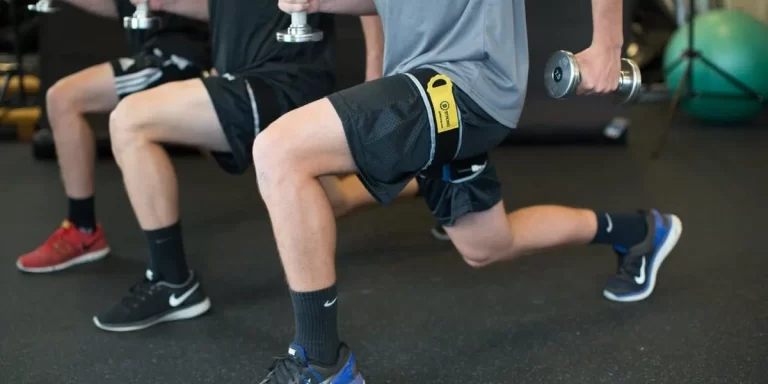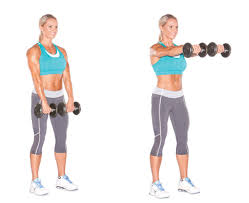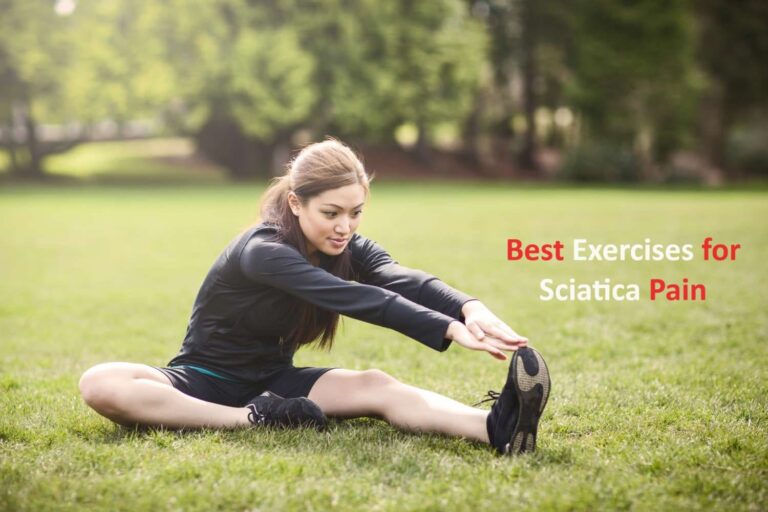Gluteal stretch: Health benefits, Types and How to do?
Gluteal stretch is a great exercise to improve flexibility of Hip muscles mainly in your buttocks area. If you are add this exercise in your workout routine, they have many health benefits and reduce the risk of injury.
What are the Gluteal stretch?
Gluteal region have three types of Gluteal muscles:
Gluteus maximus
Gluteus medius
Gluteus minimus
These are situated in your buttocks area. The gluteus maximus is the biggest muscle in the body and is in charge of generating a lot of power.
Your glutes are connected to bones in the hips, pelvis, legs, and back. this is the reason why, if your glutes are tight, you may feel tension not only in the buttocks but also in your hips, back, and surrounding areas.
Gluteal Tightness can be a result of many factors, including injury, bad posture, absence of proper warmups, muscle imbalance, or bad form when exercising. You might feel that your glutes were tight if you overwork these muscles during a workout or while playing a sport.
What is the purpose of doing glutes stretch?
There are many purposes of performing glutes stretching:
- This relieves tightness and tension in your muscles.
- Reduce discomforts, such as low back pain or tightness in your hips.
- Increase flexibility and range of motion.
- Reduce the risk of injury.
- Improve performance of physical activities.
- Improve your overall mobility.
What are the types of glutes stretch?
There are so many stretching techniques you know about:
- Seated figure-four stretch
- Standing figure-four stretch
- Supine gluteal stretch
- Seated gluteal stretch
- Downward-Facing Dog
- Pigeon Pose
- Recline Knee To Chest
- Seated twist
- Cross-legged glute stretch
- Standing side bend
- Glute bridge
- Glute bridge with band
- Seated hip abduction with resistance band
- Lizard Pose Variation
- Cow-Face Pose (Recline)
- Standing Straddle
- Rotated Low Lunge
- Kneeling Lunge Stretch
- Yogi Squat Pose
- Child’s Pose
Seated figure-four stretch
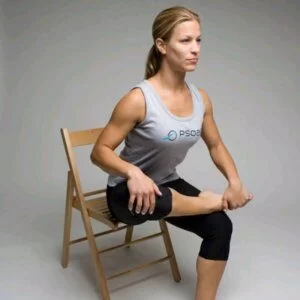
To do this stretch: Take a sitting position in a sturdy chair.
Put your left ankle on the right thigh, just above the knee.
Put your hands on the shins.
Keeping your spine upright, bend slightly forward to feel a deep stretch.
Hold for 20 seconds.
Return to the beginning position.
Repeat with the opposite leg.
Standing figure-four stretch
To do this stretch: Stand tall. keep your spine neutral.
Cross your right ankle over your left thigh, just above your knee, to make a “4” figure.
Hold on to a table for support.
Gently bend your left knee, moving the hips down into a squat position.
Pause when you feel a stretch in your right glute.
Hold for 15-20 seconds.
Return to the beginning position.
Repeat with your opposite leg.
Supine gluteal stretch

How to do it: Begin by lying flat on your back on a mat.
Bend the knees and place your feet firmly on the mat, assuring that they are hip-width apart and the spine is neutral.
Release and turn out your left leg so that your ankle is resting on your right leg, just above the knee.
Move your right knee towards your upper body, resting both hands on the back of your right thigh.
Hold this position for 15 – 30 seconds, breathing deeply continuously.
Each time that you exhale, draw your knee further into your chest and press your left elbow into your left knee to increase the stretch, assuring that the spine remains in a neutral position and your tailbone on the ground.
Repeat this stretch on the opposite side.
Seated gluteal stretch
How to do it: Take a seat in a chair. the spine is straight.
Place your left foot on your right knee just above the knee.
Now grab your left knee by your hand and draw towards your chest.
Hold when your feel stretched.
15-20 seconds hold and repeat another side.
Downward-Facing Dog
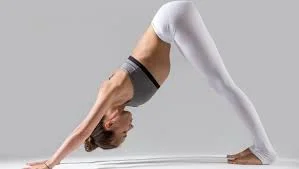
To do this stretch: Begin in a push-up position, with your hands shoulder-width apart and legs together.
Upright your body and engage the core.
Draw your hips back and up, forming an upside-down “V” with the body.
Gently bend the knees and put your head between the shoulders, keeping it in line with the spine.
Reach your heels toward the ground but keep them slightly lifted.
Hold for 15 seconds. Return to the beginning position.
Pigeon Pose

To do this stretch: Begin on all fours. Move your left knee toward your left wrist, placing your shin on the ground.
Move the left ankle toward the right wrist.
Slide your right leg back, point your toes, and keep the hips facing forward. Extend the spine.
Slowly walk the hands forward. Hold for 5–10 seconds.
Return to the beginning position. Switch your legs and repeat.
This stretching has some variations :
Standing Pigeon
To do this stretch: Stand with your feet around shoulder distance apart with your hands on your hips.
Bend your right knee to bring it across your thigh, just above the knee of your left leg.
Flex your right foot and rotate your right hip so that your right shin is parallel to the ground.
For a deeper stretch, bend your left knee and hinge at the hips.
Hold for 30- 60 seconds before repeating the motion on the other side.
Reclined Pigeon
To do this stretch: Begin with lying on the ground.
Bend your legs and the soles of your feet flat on the ground.
Raise your right leg to bring your right ankle to rest on your left thigh, just above your knee.
Flex your right foot and wrap your arms around your left thigh, slowly pulling it closer to your chest as you press your right knee away from your body.
Hold for 30 – 60 seconds before repeating on the other side.
Modified Pigeon
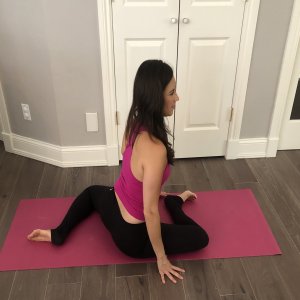
To do this stretch: Sit on the ground with your legs straight out in front of you and hands-on on either side of the hips. Then, flex your left foot, bend your left knee, and bring your shin towards the body, maintaining it as perpendicular to your thigh as you can.
Simultaneously swing your right leg behind you and bend it slowly.
Slowly press into your fingertips for balance.
Hold for 30- 60 seconds before repeating the motion on the opposite side.
Elevated Pigeon
To do this stretch: Stand as close to a table as you can.
Lift the right leg with the knee bent.
So, your leg forms a 90-degree angle, and rest your right knee and ankle on the table in front of you.
So, the knee and ankle rest parallel to the table’s edge in front of you.
Bend forward towards the shin as much as is comfortable.
When you feel stretched, hold there for 30-60 seconds and switch the legs.
Recline Knee To Chest
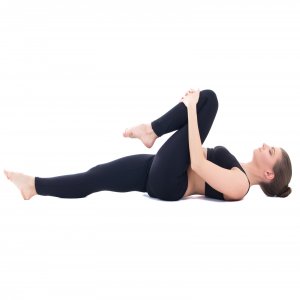
To do this stretch: Begin by lying on the back with your legs are straight.
Bend your right knee and wrap your arms around the shin.
Slowly pull the knee by your hands towards your chest.
Hold for 60 – 120 seconds, then repeat the motion on the left side.
Repeat 2 times.
Knee to the opposite shoulder
To do this stretch: Begin by taking a supine lying position on a mat and straighten your legs in front of you.
Bend and lift your lift knee and put your hands around your left knee.
Pull your left knee up toward the right shoulder.
Hold for 15- 30 seconds.
Return your left leg to the beginning position.
Straighten your left leg and repeat with your right leg.
Seated twist
To do this stretch: Sit on the ground and stretch your legs forward.
Place your right arm behind you and bring your right leg over your left.
Place your right foot on the ground near your left knee.
Position your left arm over your right knee, with the palm facing outward.
Twist to the right and use your left arm to pull your right knee inward.
Hold your position for 15 – 30 seconds.
Untwist and repeat on the opposite side.
Cross-legged glute stretch
To do this stretch: Sit on the floor cross-legged, with your right foot tucked into your left thigh.
Your left leg would be in front of your right shin.
Your arms stretched in front of you.
Slowly lean your torso forward towards your crossed legs.
When you feel, hold there for 20-30 seconds.
Repeat the stretch with your left foot tucked into your right thigh.
If you want to feel a deep stretch, down your body toward the legs even more. You can also stretch the arms out farther.
This stretch has some variations :
butterfly pose
To do this stretch: Take a butterfly shape position on the ground.
This includes sitting with the soles of the feet pressed together and the knees open on either side, with the outer thighs reaching toward the floor.
Next, lean forward to feel a deep stretch.
Hold the position 15-30 seconds and repeat.
Standing side bend
To do this stretch: This stretching will also stretch out your upper body.
Use a wall for support and balance, take a standing position with one side of the body towards a wall.
Now cross your leg afar from the wall in front of the other leg.
Place one palm on the wall and the other palm on the hip.
Then bend your body away from the wall, and push the hip toward the wall.
Hold for 15-20 seconds before repeating on the opposite side.
Glute bridge
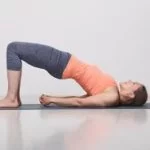
To do this stretch: Take a lying position on your back with the knees bent and your feet flat on the ground.
Put your feet hip-width distance apart and gently contract the abdominal muscles.
Slowly breathe out while maintaining your abs contracted and then raise your hips up and off the ground.
Slowly contract your glute and don’t raise your hips past the point of comfort.
Hold for 10 – 15 seconds, inhale, and gently lower yourself back to your beginning position.
Repeat 5-8 times.
Glute bridge with band
To do this stretch: Tie up a small, tight resistance band around your calves.
Take a lying position on your back and raise your hips up.
Maintain tension in the resistance band and tap the hips down to the ground before lifting them back up again.
It is important to keep your spine upright and make the motion come from the hips.
Repeat 10-15 times.
Seated hip abduction with resistance band
To do this stretch: Sit on the ground and tie up the resistance band around the calves.
Flex your knees and maintain your feet on the ground.
Put the hands slightly behind you.
Keep the back straight back and press the legs out to the sides as you do external rotation to the hip.
Slowly, and with control, bring the legs back together. Holding time should be 10 – 15 seconds.
Repeat 8-10 times.
Lizard Pose Variation
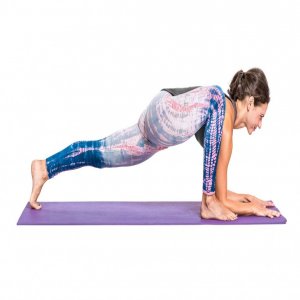
To do this stretch: Begin in a high plank position with your hands directly under the shoulders.
Bend your left knee to bring your left foot outside of your left hand, assuring your left knee is in line with your left ankle.
Rest your right knee on the floor.
Press your left foot into the floor and gently push your left knee outward.
To feel a deeper stretch,, lower your forearms to the floor.
Hold for 60 – 120 seconds before repeating the motion on the opposite side.
Cow-Face Pose (Recline)
To do this stretch: Begin with lying on your back and the legs are bent.
The soles of the feet flat on the ground. Cross your left thigh over your right.
Maintaining your head on the mat, use your hands to slowly pull your shins up toward the chest.
Bring your shins as perpendicular to your upper body as possible.
Hold for 60 – 120 seconds before repeating the motion with your right thigh over your left.
Standing Straddle
To do this stretch: Start with your feet 2 – 3 feet apart with the toes angled slightly inward.
Bend forward at waist level and walk your hands to your left ankle.
Hold for 30-60 seconds before walking your hands to your right ankle.
Repeat 3 – 4 times.
Rotated Low Lunge
To do this stretch: Begin in a high plank position with your hands directly under the shoulders.
Flex your right knee to bring the right foot outside of the right hand, assuring your right knee is in line with the right ankle.
Lift your right arm toward the roof, rotating your chest towards your right knee.
Look over your right shoulder toward the roof.
So your body forms a straight line from your head to your left heel.
Hold for 60 – 120 before repeating the motion on the other side.
Kneeling Lunge Stretch

To do this stretch : Lower into a kneeling lunge with your left knee on the ground and your right foot planted in front of you.
Put your hands on your hips and gently push your right hip towards your right foot.
Hold the position for 20- 30 seconds, switch sides, and repeat.
Yogi Squat Pose
To do this stretch : Stand with the feet wider than hip-width apart, toes facing either forward or slightly outwards.
Bend the knees and squat down as much as possible so that the hips come below the knees.
Try to maintain the back as straight and upright as possible, pressing the hands together and elbows against the insides of the knees for assistance.
Hold for at least 10 – 15 seconds and repeat.
Child’s Pose

To do this stretch: Begin on your hands and knees, with your knees placed out wider than the hips.
Sit back on the heels so the stomach lowers between the thighs.
Slowly bend forward as much as possible.
Keep your upper body long as you continue to press the hips back and the arms forward.
If comfortable, put your forehead on the ground.
Hold the position for around 20-30 seconds and repeat.
What are the common mistakes done during stretching?
There are certain mistakes you shouldn’t make during stretch:
Not Warming Up Before Stretching
Stretching after warm up motions decreases the risk of injury by giving unexpected flexibility to your muscle. Never perform stretching without a prior warm up period unless you feel pain in your muscles.
Not Stretching At All
Always perform stretching before any exercise workout which helps your muscles to activate and take a load into them. Without any muscle stretching, you put your muscles in danger or it may tear your muscles because of sudden weight loading into them.
Not Stretching For Enough Time
You have to stretch your muscles for enough time, every stretch requires a different amount of time. Static stretching should be around 30 – seconds, dynamic stretch is required 10-12 repetitions.
Forgetting to Breathe
Don’t forget to breathe during the stretch, because you need more oxygen during the stretch. So make sure you continue your breathing while performing a stretch.
Stretching Into An Injury
If you are injured, you have to avoid stretching through that injury pain. Stretching makes your muscles suffer and causes lots of pain, so make sure to not stretch any injured area.
Stretching Until It Hurts
Don’t stretch your muscles until you feel pain. Stretching should be in a mild painful manner that is little forced at the end of the stretch. So much pain during a stretch makes your muscles injured and damaged. Overstretching is dangerous for you.


